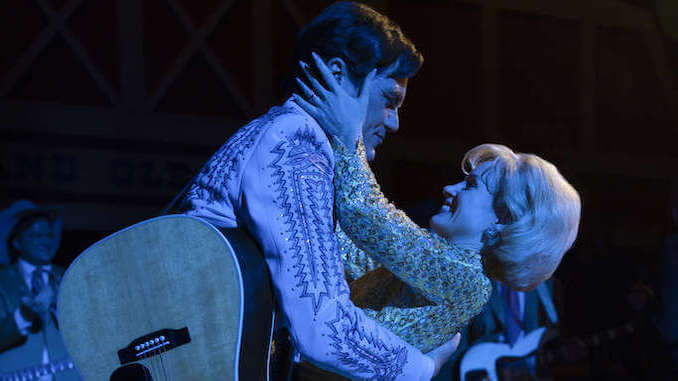A Muddled George & Tammy Doesn’t Quite Do Justice to the Legendarily Magnetic, Complicated Pair
Photo Courtesy of Showtime
“Look at how they look at them.”
From George Jones and Tammy Wynette’s first performance together, they had an electric, palpable chemistry, felt from the front row to the rafters. Achingly sweet love songs shot the couple to stardom, and throughout the tumultuous decades of their intertwined careers, they got married and divorced, recorded nine records together, and had their only child, Georgette Jones. Georgette’s book, “The Three of Us: Growing Up With Tammy and George,” now serves as the basis for Showtime’s new miniseries George & Tammy. Reuniting Michael Shannon and Jessica Chastain, the series relies heavily on the actors’ own chemistry and the longevity of Jones and Wynette’s impassioned lyrics, rather than the strength of its own story.
Created by Abe Sylvia (The Eyes of Tammy Faye), George & Tammy attempts to tell another side of their story, one that digs deeper into the crafted mythologies of George Jones and Tammy Wynette to reveal Glenn and Virginia, the two flawed individuals underneath the rhinestone facades. But the series consistently falls flat in this goal, often relegating the troubled stars to hollow representations of drug addiction and alcoholism. Chastain and Shannon only scratch the surface of Wynette and Jones’ magnetic connection, but for a little while that’s enough to propel the series.
With each of the miniseries’ six episodes named for a song, the show falls into a trap of its own design. In Episode 2, “Stand By Your Man,” George is already slipping away from Tammy and deeper into the bottle. By “Two Story House,” they’re recording from two booths separated by a thick piece of soundproof glass. Sylvia and director John Hillcoat’s desire to recreate these defining moments and present them with their accompanying ballads holds the series back from ever reaching any further intimacy with Jones and Wynette. Hillcoat is a seasoned music video director and brings this aesthetic to the series, for better and for worse; the performances throughout the series are well-shot, even if sometimes hindered by the actors’ own singing. Shannon and Chastain are both perfectly serviceable singers, but it does them no favors to try to represent such well-known voices in country music. Shannon is nowhere near the depths of Jones’ register and doesn’t really try to get there. His distance from Jones’ range only accentuates Chastain’s attempted mimicry. Her drawl is emphasized and elongated in an attempt to replicate Wynette’s iconic twang, straddling the line between hokey and faithful. But it’s impossible to come close to Tammy’s singular voice, the resonating love and pain that emanated from every note she sang.
George & Tammy spans decades, from the first time the two met in the 1960s to Tammy’s death in 1998. In just six episodes, time has to move quickly, and the show rarely looks outside the world George and Tammy built around the music they created. One of the series’ most stunning flaws is how it marks the passing of time by which man Tammy was romantically linked to at the time. Wynette first married at age 17; George Jones was her third of five controlling, abusive husbands. But there’s no interrogation of the cycles that kept her seeking out and appeasing a certain type of man or the systems that may have withheld her independence. (Let’s not forget women could be legally barred from opening a credit card without her husband’s approval until 1974, the year after George and Tammy’s fifth album together.) More than a few stomach-churning moments remind us of how it was even easier for women to be stripped of any autonomy, but by staying so close to the subjects, most cultural elements like this are left to implication. Because Tammy Wynette was such a trailblazer for female country performers, it feels like a disservice to minimize the pressures that affected her outside of her relationships. In the showrunners’ quest to get outside of the over-reported “what’s it like to be a woman in Nashville?” story, they strip a significant layer of her story away, rather than make her more three-dimensional as intended.